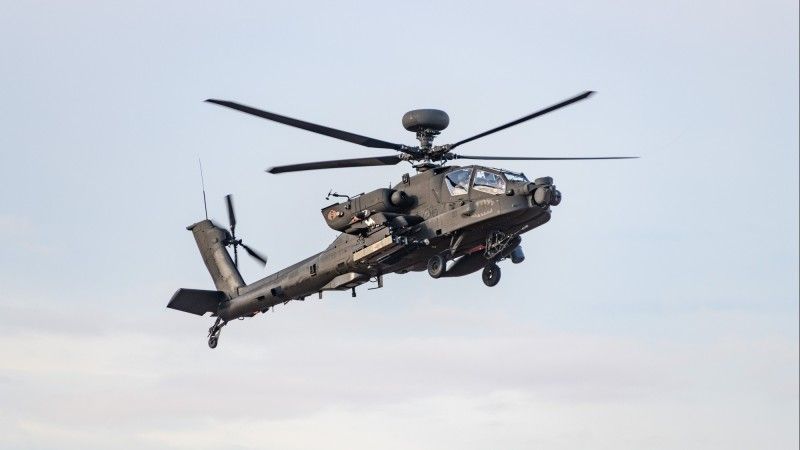Industry
Spike NLOS: Apache long arm

Photo. US Army
The US Army is finalizing the integration of Spike NLOS anti-tank guided missiles on AH-64E Apache Guardian helicopters this year. Thanks to this, they will be able to engage targets at distances of up to 32 km. Such missiles have already been integrated on other versions of Apache helicopters, as well as on Black Hawk helicopters and others. Spike NLOS can also be used on naval vessels and ground based tank destroyer vehicles. They are also offered to Poland.
The US Army has been preparing to deploy Israeli Spike NLOS anti-tank guided missiles on AH-64E Apache Guardian helicopters for several years. The need to introduce a system of this kind was recognized at the end of the last decade. As Defense News reminds, the Americans decided that the helicopters need weapons with a range longer than the Hellfire missiles and the future JAGM. Those missiles would be used, main justification is to engage with targets that are beyond the line of sight among other things, to destroy enemy air defense systems that pose threats to the helicopters operation in a danger zone while destroying the threats. While the standard ATGMs used by Apache can - according to available information - fight targets at a distance of up to about 8-10 km (it can be increased to more than a dozen kilometers in the new JAGM-MR version), the Spike NLOS can engage targets at a distance of up to 32 km.
The American government made the decision to implement Spike NLOS on Apache helicopters in 2020, after earlier live fire test. These missiles are being acquired in parallel with the implementation of the Long Range Precision Munition (LRPM) long term program aimed at preparing a new generation of long-range weapons for helicopters (including Future Attack Reconnaissance Aircraft reconnaissance and combat rotary wing platforms).
The Objective LRPM system is intended - according to official Pentagon documents (FY 2024 Budget Request) - to play a key role on a multi-domain battlefield and allow operation despite the presence of strong anti-aircraft defense and electronic warfare systems. In this program, Spike NLOS is one of the participants, and the project is still at the competitive stage. It is likely that American industry will be involved in the Objective LRPM project.
However, the currently implemented Spike NLOS purchase for Apache is called LRPM DR (Directed Requirement), because it concerns the direct purchase of an existing weapon system with parameters consistent with the requirements of the LRPM program. The Spike NLOS system will allow Americans to obtain the appropriate capability much earlier than the objective LRPM is achieved, because the latter can be implemented into the broad service only around 2030 or later. And this - long before the outbreak of a full-scale war in Ukraine - was considered a too long time to wait.

Photo. US Army/USAF
Since 2020, various types of tests and trials have been carried out related to the use of Spike NLOS missiles on Apache helicopters. For example, in 2021, the US Army announced that it would conduct tests involving shooting at a sea target at a distance of as much as 32 km. Relatively recently, in December 2023, Lockheed Martin reported that eight Spike NLOS missiles were successfully fired within five days as part of the so-called tests. AirWorthiness Release (AWR). This is an important step towards formal approval for the operational use of the Spike ATGM on the American helicopters.
It is expected that the integration process on the first 18 AH-64E v. 6 helicopters will be completed by September 2024, and training for US Army soldiers will be conducted before that. Thanks to this, the American Apache, in the latest version, will gain a „long arm”.
The combination of the capabilities of the Apache Guardian helicopter and the Spike NLOS missile will give the American Army Aviation completely new capabilities. Apache Guardian helicopter are equipped with a Link 16 data link, which allows the transmission of information about targets to and from various sources. They also have a new version of the Longbow radar with a range increased to 16 km and other advanced sensors.
What capabilities do Spike NLOS missiles offer? In the basic version, they are radio-controlled, long-range anti-tank guided missiles that can hit targets at distances of up to 32 km. They have dual optoelectronic thermal and TV guidance. They can engage stationary and moving targets, two-way communication between the missile and the launcher is also possible, and the guidance system is independent of the GPS signal. Spike NLOS were successfully used in combat.

Photo. M.Dura
Recently, however, modifications have been introduced to the Spike NLOS missiles known as the Spike NLOS 6th generation. Those missiles allow the range to be increased to approximately 50 km if launched from the aerial platform (helicopter). In addition, it is possible to shoot at a target with specific coordinates („fire-to-grid”) and then use the guidance system (EO) to search for a target with specific parameters. The EO guidance system is also able distinguish targets according to previously established patterns. In addition, one operator can direct a salvo of up to four missiles. The range of Spike NLOS 6th generation is multiple times other ordnance carried by Guardian.
All this means that Spike NLOS missiles can be a very significant reinforcement of the armament of Apache Guardian helicopters. Depending on the situation, they can engage various targets, from anti-aircraft defense systems, which the Americans focus on, through armored weapons (also in the „top attack” mode, i.e. an attack on the armor of the target), to fortifications.

Photo. IDF Spokesperson Unit/Wikipedia
Not just Guardian
Spike NLOS ATGMs can be used on attack and multi-role helicopters, as well as on many other platforms. Before they were used on American Guardians, they were integrated - and used in combat - on older variant Apache helicopters used in Israel. Greece also decided to use them on older Apaches in 2021, considering them a valuable addition to the combat system, especially in coastal conditions.
Both Israel and, in the future, Greece will also use Spike NLOS on ground launchers and on surface vessels. Another user of Spike NLOS is the Republic of Korea, which has four-missile ground launchers on Plasan SandCat 4x4 vehicles (similar to those used by the Polish Military Police). Spike NLOS are also used by South Korean AW159 Wildcat helicopters, much lighter than the Apache. Spike NLOS is also used in Black Hawk helicopters used in Colombia, under the designation AH-60L Arpia IV.

Photo. Republic of Korea Army
In 2021, Spike NLOS firing from an integrated launcher on the JLTV multi-role vehicle was carried out in Estonia, and a year later the first launchers of these missiles on JLTV were received by American special forces (US SOCOM). Spike NLOS can therefore be used on various platforms and in various configurations, making it possible to hit targets - including armored ones - at considerable distances.
Technology transfer
Spike NLOS missiles are also proposed by Israeli Rafael Poland, along with technology transfer. Their production, similarly to the case of Spike-LR, could take place at the Mesko plant in Skarżysko-Kamienna, which increases the security of supplies and ensures investment in the domestic economy. Moreover, in the event of an order for Spike NLOS, the Polish company would be included to a greater extent in the supply chain for Spike family missiles, which translates into additional export revenues.
One of the platforms that, in the case of Poland, could carry Spike missiles are, of course, the Apache Guardian helicopters planned to be acquired. In this case, the configuration of Polish helicopters would be largely consistent with that introduced by the US Army. This would likely facilitate the integration process.
It is also possible to integrate Spike NLOS on Black Hawk helicopters in the battlefield support version or on ships. These missiles are also offered in a ground application, for use in the Ottokar-Brzoza tank destroyer program. In such a case, the launcher would be integrated with the Polish 4x4 carrier, as was previously the case with the JLTV and SandCat vehicles, and the guidance system would be integrated with the Polish Topaz fire control system, which is included in the Ottokar-Brzoza program.
The Spike NLOS system is constantly being developed, and will soon become an important element of the US Army aviation armament. It can constitute a contribution to anti-tank defense and, more broadly, to the system of engagement targets that are out of sight of to the operator (in accordance with the „Non-Line of Sight” assumption), as evidenced by the introduction of these missiles to more and more countries, both on air, land and sea platforms.
